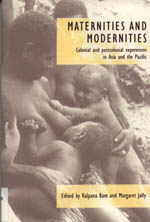-
This very interesting collection of eight essays singlemindedly focuses on motherhood (maternities) ranging across South Asia, Southeast Asia and the Pacific during colonial and postcolonial times. For the most part it focuses on countries colonised by the British, and Australians for Papua New Guinea. As Margaret Jolly iterates in the 'Introduction', the focus provides the reader with experiences and discourses about maternity in regions where colonialism and postcolonial development have connected indigenous women with their European counterparts. This has not always been through adoption of the latter's ways but through challenge, rejection and embracement. These have led to transformations through choice while contesting the realm between 'tradition' and 'modernity'. Modernity which has brought intervention notably in the form of ideas about improving, medicalising the mothering process and disciplining mother love, also emphasises the corporeality of the female body.
-
The Foucaultian ideas of governmentality, pastoral care and surveillance of populations were and remain central to the operation of colonial and postcolonial states. Nevertheless, hierarchies of race were constructed and emerge in various forms. Indigenous women are the 'Other' who need to be taught new and different ways of becoming better mothers or midwives by superior women (European women and/or missionaries), different in class, ethnicity and race. The historical accounts by Lenore Manderson and Jane Haggis which precede the contemporary modern women's accounts of Maila Stivens (Malaysia) and Kalpana Ram (South India) respectively, provide essential background material to explain continuities and change at the intersections of tradition and modernity. Stivens highlights the tensions between a western feminist discourse and a middle class Islamic, Malaysian one, where Malaysian women appear to be suffering mothers juggling dual occupations and producing the 'nation-building child' (p.72). I was particularly drawn to the various resonances articulated by some authors who are young mothers themselves e.g. Maila Stivens, Kalpana Ram and Christine Dureau and their Asian sisters in coming to terms with modernities, albeit different in space and place.
-
Missionising women of the encounter period is a theme running through several essays, including those of Margaret Jolly, Kalpana Ram, Leanne Merret-Balkos and Christine Dureau. Western medicine often associated with missionaries emerges as the force behind changing ideas about hygiene, birthing practices and their medicalisation. Merret-Balkos' account of the Anganen of the Papua New Guinea southern highlands where women embodied their resistance by protesting against missionary medical staff taking away the afterbirth at confinement is particularly poignant here. The symbolism of the cord (what these women are left with) - its connection between mother and child and a metaphor for relatedness to offspring and to men emphasises the strong link between self, identity and birth. In many respects these ideas about birth and the new-born child are similar to those in many Southeast Asian cultures.
-
Santi Rozario's depiction of the contestation between the dai (traditional midwife) and the doctor as a contest between not only tradition and modernity but also of religion and science and female-centred rather than male-centred birth leaves little space for romanticising about traditional birth in Bangladesh. On the other hand, the changing emphasis of social relations among the Simbo (Dureau) highlights the changing power relations for women from autonomy to one of increasing burden under their husbands' directives including no free access to family planning.
-
Ram's powerful epilogue draws the collection of essays together by situating maternities and modernities within the academic scholarship of anthropology, feminism and western philosophy. The collection very successfully deals with relations between culture and bodily experience and the construction of the female body within and through the relations of power. As Ram describes it, 'there is a growing conceptualisation of birth as 'an arena within which culture is produced, reproduced and resisted' (p.279).
-
This collection is important because it breaks new ground in understanding maternities and modernities. Each essay brings to the collection interesting ethnographic material and arguments. It is a book for feminists, anthropologists, those who belong to other academic disciplines, as well as regional specialists. As such it occupies an important place in the literature offering perspectives of the female body.

|

